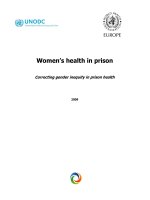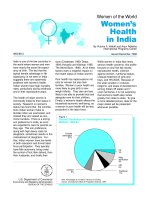Women’s networks in medieval france
Bạn đang xem bản rút gọn của tài liệu. Xem và tải ngay bản đầy đủ của tài liệu tại đây (3.23 MB, 280 trang )
T H E
N E W
M I D D L E
Women’s Networks in
Medieval France
GENDER and COMMUNITY in
MONTPELLIER , 1300-1350
Kathr yn L. Reyer son
A G E S
The New Middle Ages
Series Editor
Bonnie Wheeler
English & Medieval Studies
Southern Methodist University
Dallas, Texas, USA
The New Middle Ages is a series dedicated to pluridisciplinary studies
of medieval cultures, with particular emphasis on recuperating women’s
history and on feminist and gender analyses. This peer-reviewed series
includes both scholarly monographs and essay collections.
More information about this series at
/>
Kathryn L. Reyerson
Women’s Networks in
Medieval France
Gender and Community in Montpellier, 1300-1350
Kathryn L. Reyerson
Department of History
University of Minnesota
Minneapolis, Minnesota, USA
The New Middle Ages
ISBN 978-3-319-38941-7
ISBN 978-3-319-38942-4
DOI 10.1007/978-3-319-38942-4
(eBook)
Library of Congress Control Number: 2016942914
© The Editor(s) (if applicable) and The Author(s) 2016
This work is subject to copyright. All rights are solely and exclusively licensed by the
Publisher, whether the whole or part of the material is concerned, specifically the rights of
translation, reprinting, reuse of illustrations, recitation, broadcasting, reproduction on
microfilms or in any other physical way, and transmission or information storage and retrieval,
electronic adaptation, computer software, or by similar or dissimilar methodology now
known or hereafter developed.
The use of general descriptive names, registered names, trademarks, service marks, etc. in this
publication does not imply, even in the absence of a specific statement, that such names are
exempt from the relevant protective laws and regulations and therefore free for general use.
The publisher, the authors and the editors are safe to assume that the advice and information
in this book are believed to be true and accurate at the date of publication. Neither the publisher nor the authors or the editors give a warranty, express or implied, with respect to the
material contained herein or for any errors or omissions that may have been made.
Cover illustration © P. Eoche / Getty Images
Printed on acid-free paper
This Palgrave Macmillan imprint is published by Springer Nature
The registered company is Springer International Publishing AG Switzerland
This book is dedicated to Allison Reyerson, Brittany Wenzel, and women of
the future.
PREFACE
I am grateful to the University of Minnesota and the Department of
History for a single-semester leave in spring 2015 and for earlier leaves that
provided me with time to write, as well as for McKnight and McMillan
fellowships. I thank the Archives municipales de Montpellier and the
Archives départementales de l’Hérault for support in my research over
many years. I also wish to thank the University of Minnesota Interlibrary
Loan services for assistance.
I am grateful for the many audiences who listened to earlier versions
of parts of this study in France, Italy, and Spain, at the Sorbonne in the
seminar of Claude Gauvard and Robert Jacob, at the École Normale in the
seminar of François Menant, at the École française de Rome, and at the
Casa de Velásquez in Madrid.
I am indebted to colleagues Marguerite Ragnow and Ruth Karras for
reading earlier versions of this book. To Maggie in particular, a special
thanks for all the invaluable criticism and suggestions over the years.
Remaining errors are my responsibility alone.
vii
ACKNOWLEDGMENTS
Some material included here, now considerably reworked, was originally
published in:
“The Adolescent Apprentice/Worker in Medieval Montpellier,” The
Journal of Family History: The Evolution of Adolescence in Europe, ed.
Barbara A. Hanawalt, 17 (1992): 353–370.
“Prostitution in Medieval Montpellier: The Ladies of Campus Polverel,”
Medieval Prosopography 18 (1997): 209–228.
“Public and Private Space in Medieval Montpellier: The Bon Amic
Square,” Journal of Urban History, 24 (1997): 3–27.
Thanks are due the Cartography Laboratory of the Geography
Department of the University of Minnesota for drawing the maps.
ix
CONTENTS
1
1
Agnes de Bossones’s Origins, Marriage, and Litigation
2
Agnes’s Family Networks
19
3
Agnes’s Networks of Property
29
4
Marriage
41
5
Apprenticeship
67
6
Urban–Rural Connections
91
7
Women of the Marketplace: Horizontal and
Vertical Links
111
A Community of Prostitutes in Campus Polverel
129
8
xi
xii
CONTENTS
9
Agnes’s Networks of Philanthropy
147
Conclusion
175
Appendix 1: Women Market Sellers
181
Appendix 2: Prostitutes
183
Appendix 3: Burial Requests to the Dominican House
189
Appendix 4: Burial Requests to the Franciscan House
191
Appendix 5: Transcription and Translation of the
Will of Agnes des Bossones
193
Bibliography
217
Index
239
LIST
OF
MAPS
Intro. Map. 1 Montpellier and its region
Map. 3.1
Montpellier, its gates and suburbs.
Inset of the Herbaria Square
Map. 4.1
Immigration according to
the marriage contracts
Map. 5.1
Geographic origins of apprentices and workers
Map. 7.1
Central Montpellier: The Herbaria Square
xxviii
32
50
71
112
xiii
LIST
Chart 2.1
Chart 3.1
Chart 4.1
Chart 9.1
Chart 9.2
OF
CHARTS
Agnes and Petrus’s children and grandchildren
Agnes’s testamentary gifts to her family members
Montpellier consulate
Bequests to individual women religious
Donations to women’s orders
24
31
44
157
157
xv
NOTE
ON MONEY
The coinage mentioned in this study is that of Tours (livres tournois). One
livre (pound) was worth 20 sous (shillings), and one sous was worth 12
deniers (pennies). Coinage citations are abbreviated as livre (l.), sous (s.),
and denier (d.) In rare instances where “current money” was mentioned,
the fact is noted. For a detailed discussion of monetary problems in the
first half of the fourteenth century, see Business, Banking and Finance in
Medieval Montpellier (Toronto: Pontifical Institute of Mediaeval Studies,
1985), Appendix 2.
xvii
ARCHIVAL CITATIONS
I have been guided throughout this book in my citation of notarial folios
by the archivists’ renumbering in pencil of otherwise older inconsistent
folio numbering of the surviving registers. Any questionable citation can
always be verified by the date of the notarial act.
xix
INTRODUCTION
There are few book-length studies of urban women’s actions within the
patriarchal society of the Middle Ages.1 The life and experiences of Agnes
de Bossones offer an entry into the world of medieval Montpellier in the
first half of the fourteenth century.2 I have chosen to pursue networks
and communities, particularly among women, with Agnes as my narrative
thread, in order to address the question of what women could and did
do in the patriarchal society of the Middle Ages. Connections between
women and men were also important and will be treated when pertinent.
My focus is on those networks in medieval Montpellier, a large urban
center in southern France in the region of Languedoc, for which I have
sources, that is, on the society, the economy, and urban philanthropy.
The archival materials of Montpellier—notarial registers, charters, urban
statutes—provide the evidence and reveal the contexts in which women
interacted, in business, in finance, in the marketplace, in philanthropic
settings, and, of course, in the family. Absent from this study is a focus on
networks among religious women, which could be the subject of another
1
The most effective recent statement on patriarchy is that of Judith M. Bennett, History
Matters. Patriarchy and the Challenge of Feminism (Philadelphia: University of Pennsylvania
Press, 2006).
2
My most recent publications addressing the issue of women’s agency are “La participation des femmes de l’élite marchande à l’économie: trois exemples montpelliéraines de la
première moitié du XIVe s. ” in Études Roussillonnaises XXV, sous la direction de Christiane
Klapisch-Zuber (2013): 129–135, and “Urban Economies,” in Judith M. Bennett and Ruth
Mazo Karras, eds. Oxford Handbook on Medieval Women and Gender (Oxford: Oxford
University Press, 2013), 195–210.
xxi
xxii
INTRODUCTION
book.3 Networks were present in family relations, in marriage, in apprenticeship, in urban–rural relations, in market activities, among prostitutes,
and in urban charity. Concepts of neighborhood, affines, patronage, kinship, household, and hangers-on have been studied, but the operation of
vertical and horizontal ties can still offer insights regarding the experiences
of medieval urban women in a particular urban environment.4 Setting the
history of women in a specific historical context—medieval Montpellier—
and introducing comparisons with that of men permit a clearer understanding of how women navigated in a medieval urban setting where legal
norms reflecting the patriarchal society were often at odds with actual life
experiences. Too often in the past, historians have focused on the prescriptive and legal sources and not on documents of practice. The picture we
have from the latter is very different from that of normative sources.
As a general rule, neither wills nor marriage contracts are extant for
most of the people encountered in the notarial and charter evidence,
although there might be considerable other information about their activities. The survival of Agnes’s will is fortuitous in light of the other information extant on her behalf, extending over 40 years.5 It permits a glimpse
into her charitable and philanthropic orientation, allowing us to trace her
support for the Ladies of Wednesday, a charitable women’s group that collected alms, and to detect philanthropic networks in the town. It furnishes
information on her large family and on her property holdings. Agnes’s life
3
Marthe Moreau, L’Âge d’or des religieuses. Monastères féminins du Languedoc méditerranéen au moyen âge (Montpellier: Presses du Languedoc/Max Chaleil éditeur, 1988), has
written a general history of traditional religious houses for women in Languedoc. There has
been focus on Cathar women by Anne Brenon, Les femmes cathares (Paris: Perrin 1992), and
John Hine Mundy, Men and Women at Toulouse in the Age of the Cathars (Toronto: Pontifical
Institute of Mediaeval Studies, 1990), though clearly not all Toulousaines were Cathar.
Louisa A. Burnham, So Great a Light, So Great a Smoke. The Beguin Heretics of Languedoc
(Ithaca: Cornell University Press, 2008) focused mostly on men. See also the very interesting
collection of articles in Cahiers de Fanjeaux 23: La Femme dans la vie religieuse du Languedoc
(XIIIe–XIVe s) (Toulouse: Privat, 1988). No monograph on networks of religious women
for the region of Languedoc exists.
4
See, for example, Diane Owen Hughes, “Urban Growth and Family Structure in
Medieval Genoa.” Past and Present 66 (1975): 3–28; David Herlihy and Christiane KlapischZuber, The Tuscans and Their Families. A Study of the Florentine Catasto of 1427 (New
Haven: Yale University Press, 1985); and David Herlihy, Medieval Households (Cambridge
MA: Harvard University Press, 1985).
5
Archives municipales de Montpellier (hereafter A.M. Montpellier), BB 3, J. Laurentii, f.
13rff. See the transcription and the translation of Agnes’s will in Appendix 5.
INTRODUCTION
xxiii
offers a lens through which to view women’s networks and the operation
of gender and community in medieval Montpellier.
Although the work that follows is an empirical study, informed by archival evidence, some consideration of the theoretical underpinning of women’s networks is useful by way of introduction. New ways of envisioning
the medieval city have come from critical theory, sociology, anthropology,
and geography. Sociologists have made of network theory a sophisticated
form of analysis with formulae, the data for which are often absent in the
Middle Ages. While acknowledging the usefulness of social network analysis for studying society, given the problems of medieval data, I have chosen
to privilege individuals, particularly Agnes, and their stories as a means of
discovering linkages, a more informal term than networks that is perhaps
better suited to medieval social and economic history.6 I will still use the
term “network” but in nontechnical ways.
Today, it is “who you know” and the kind of support networks you
enjoy that are a good gauge to success or failure in business, society, and
life in general.7 Similarly, the Middle Ages were rife with networks that
underpinned the society and permitted it to function.8 A network of
friends and family to sustain one, at all levels of society, was important,
particularly among the poor and sick in a large medieval city.9 Networks in
medieval society provided the basis for social, capital, political, and symbolic capital.
6
See the interesting new collection, Commercial Networks and European Cities, 1400–
1800, ed. by Andrea Caracausi and Christof Jeggle, no. 32 of Series Perspectives in Economic
and Social History (London: Pickering and Chatto, 2014). For caveats regarding the use of
the term “network,” see Mike Burkhardt, “Networks as Social Structures in Late Medieval
and Early Modern Towns: A Theoretical Approach to Historical Network Analysis,” 13–45;
according to Burkhardt, each actor has to have at least two ties to others in the network in
social network analysis (15).
7
Social media facilitate a whole host of networking possibilities now available on Facebook,
Twitter, listservs, email, and so on.
8
Connections based on political, social, economic, and symbolic capital provide a framework that can be useful for the Middle Ages in its possibilities for the study of networks. See
Pierre Bourdieu, The Logic of Practice (Stanford: Stanford University Press, 1990). Also useful for the study of medieval networks are Michel de Certeau’s relational networks or systems
of operational combination (combinatoires d’opérations) in The Practice of Everyday Life,
trans. Steven Rendall (Berkeley: University of California Press, 1988), xi–xii.
9
Sharon Farmer, Surviving Poverty in Medieval Paris. Gender, Ideology, and the Daily Lives
of the Poor (Ithaca and London: Cornell University Press, 2002).
xxiv
INTRODUCTION
The concept of social capital has a long history preceding its emergence
as a central concept in the work of Pierre Bourdieu.10 As Alain Degenne
and Michel Forsé stated in 1999:
The idea goes back to Hobbes (1651) who says in Leviathan, ‘to have
friends is power.’ Here he establishes a distinction between an individual’s social and political resources and implies that a person’s living standard depends on the resources at her disposal. Weber [Max Weber] uses
this last idea in his analysis of social inequalities. He asserts individuals can
improve living standards with three types of resources: economic, political
and symbolic. Economic resources govern her chances of access to wealth
and assets…Symbolic resources govern access to social distinctions, i.e. prestige…Political resources govern access to power.11
Degenne and Forsé go on to comment, “Ever distinct from other forms,
social capital consists of an individual’s personal network and her chances
of accessing whatever is circulating there, e. g. information.”12 In the present book, various forms of capital—social, economic, and symbolic—can
be viewed in the networks operating among women and between women
and men in medieval Montpellier.13
Scholarly interest in networks is closely linked with an interest in urban
space, how it was used and what kinds of human interactions it promoted. In a recent collection, Cities, Texts and Social Networks 400–1500.
Experiences and Perceptions of Medieval Urban Space, the editors Caroline
Goodson, Anne E. Lester, and Carol Symes discussed critical theory and
postmodern critique, arguing that the work of Walter Benjamin, Henri
Lefebve, Michel Foucault, Pierre Bourdieu, and Michel de Certeau “profoundly reshaped conceptions of the city as a place of lived and living
interaction.” 14 While this is a very positive trend, there exists a tendency
10
Pierre Bourdieu, “Le capital social, ”Actes de la Recherche en Sciences Sociales 31 (1980):
2–3, and The Logic of Practice (London: B. Blackwell, 1990).
11
Alain Degenne and Michel Forsé, Introducing Social Networks, trans. by Arthur Borges
(London: Sage Publications, 1999), 115–116.
12
Degenne and Forsé, Introducing Social Networks, 116.
13
Women were not formal participants in politics in medieval Montpellier. They may have
operated behind the scenes.
14
Caroline Goodson, Anne E. Lester, and Carol Symes, eds. Cities, Texts and Social
Networks 400–1500. Experiences and Perceptions of Medieval Urban Space (Farnham, Surrey:
Ashgate, 2010), 12. This volume reflects welcome diversity in its inclusion of studies of
southern Europe and the Islamic world along with articles on northern Europe.









